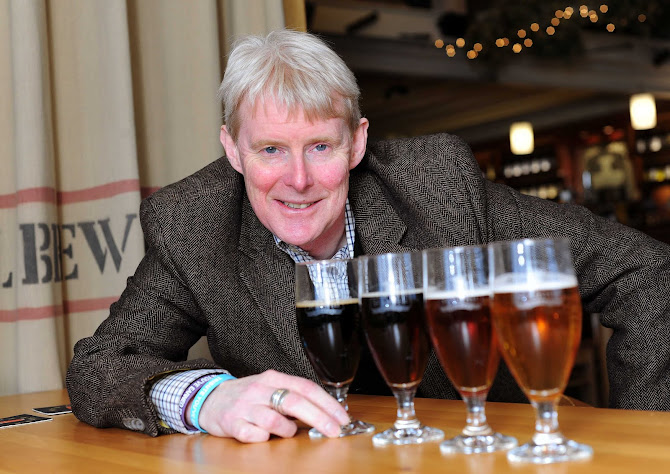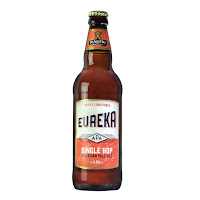A lover of beer and cheese, I decided to indulge myself by choosing some of my favourite Cornish bottled beers to match equally favourite Cornish cheeses. In my view the beer and cheese food match is one of the very best so its been great fun and equally satisfying to define this further.
I will make no excuses that my favourite Cornish beers are all from St Austell Brewery. An established major player in the South West, their beer range is so diverse in terms of style and flavours that its hard to beat when looking for an interesting, varied and quality beer selection.
For the cheeses I've tried to select the major Cornish cheeses, ones that you just might find in a local supermarket or delicatessen, so if you want to try these yourself there is every chance of finding them. There are certainly other wonderful cheeses produced in Cornwall by smaller cheese makers so my apologies to those for not making my selection.
So here we go, here are my selections.
Proper Job IPA and Cornish Blue

Proper Job is quite possibly my favourite bottled beer and one that always forms part of my weekly beer festival. A modern 5.5% abv IPA, it has plenty of resinous pineapple and citrus on the palate with a bitter back bone that does not hide away to keep your taste buds in check. The mouth feel is fresh and not overly big, so its quite capable of contrasting a full creamy cheese.

Cornish Blue has been crafted on the edge of Bodmin moor by Philip and Carol Stansfield on their farm using milk from their Friesian herd since 2001. The cheese is mild, creamy and sweeter than other blue cheeses and not one to rival a more robust Stilton in flavour, being more delicate and subtle but no less enjoyable. A past winner of the Tesco Cheese Challenge, Cornish Blue's most prestigious award came in 2010 when it was judged World Champion cheese and in the same year it was Champion cheese at the Bath and West Show. It can be found at many food Festivals across the region and likewise some of the larger supermarkets will have it on sale in their specialist cheese section.
This is not a strong blue cheese, its sweetness and butter overtones offer a fine contrast to the bold forward resins and bitterness of Proper Job. The latter can also make a fine match to a sweet dessert and in Cornish Blue its certainly found a similar partner on the cheese board.
Eureka American Pale Ale and Cornish Gouda
Eureka APA is a relatively new 4.9% abv beer from St Austell. Its brewed using the single hop variety in up and coming American Eureka hop and its most definitely in the craft beer style as befits the label design. Eureka has a hint of wild garlic on the nose, and this follows through onto the palate which can be described as caramel with and hints of onions combined in one. Craft beers are meant to challenge the taste buds, and Eureka is certainly no back number in the craft beer stakes but its still a lovely beer with bold hop flavours to the fore.

The cheese partner needs to be big and whole hearted to keep pace with Eureka and Mature Cornish Gouda is right up there. Made by Giel Spierings from a Dutch family that moved to a farm near Looe in 1998, they found milk production was not longer commercially viable so son Giel set about offering an alternative income and founded the Cornish Gouda Cheese company using traditional cheese making skills leaned in Holland. Cornish Gouda is matured for 10 to 12 months to allow for crystals to form for a crunch on the palate.
The Mature Cornish Gouda is a past winner of the Best Hard Cheese at the Great British Cheese Awards so its build up a sound pedigree. Rather like Eureka, caramel is part of the flavour make up and its a bit nutty and of course above all there is creaminess. it works well with the hints of hop garlic flavours in Eureka, rather like cheese and pickle. Both of these offerings are a little unusual in their own way but none the less very tasty, perhaps that's why they make such good bedfellows.
Cornish Gouda can be found at Food Festivals and at some delicatessens. If you still struggle to find it then visit the website
www.cornishgouda.co.uk to find your nearest stockist.
Bad Habit and Cornish Brie
Bad Habit is a wonderful deep golden Belgian style Tripel, sweet, spicy and orange zesty with plenty of condition and a bit of yeastiness, plus at 8.2% it will solve all your problems, at least for an evening! However here is a lovely beer, similar to something like Tripel Karmeliet but not as sweet. St Austell brew this as part of their small batch programme of specialist beers and is available in 330ml bottles direct from the brewery. It can be a harder to track down in shops so contact the brewery direct and buy on their online shop.

For its cheese partner the zestyness of this beer will cut through a thick creamy adversary so I choose a ripe Cornish Brie match up to this beer. Cornish Brie tends to be milder so make sure you find a more robust one like St Endellion luxury Brie. This uses double cream so not ideal if you are watching your weight but it is a real treat with a dreamily rich flavour. This cheese comes from the Arla Group who make cheese at their Trevarrian Creamery on the North Cornwall coast between Newquay and Padstow. This cheese is available through specialist delicatessens and some supermarkets.
Cardinal Syn and Davidstow Vintage Cheddar
Another Belgian style beer from St Austell, this time its Bad Habits deeper more sinister bother in the Belgian style Dubbel Cardinal Syn. Not quite as strong at 7.8% abv, its a much heavier beer on the mouth feel and the palate. Alluringly deep ruby in colour, the taste is spiced molasses black treacle combined fruity dark berry flavours and hints of medicinal, it will leave you with a warming after-glow and satisfied smile.
Cardinal Syn is another St Austell Small Batch Beer and best obtained from the brewery packaged in 330ml bottles. Mind you, that will be enough, a lovely beer to finish an evening on.

This beer needs an equally big partner. There are many cheddars in Cornwall but one of the most consistent and best comes from perhaps the largest cheese maker in the county in Davidstow. Tempted as I was to pair Cardinal Syn with an equally hidden gem of a cheese, why not use the big brand if its a fine cheese, so I recommend Davidstow Extra Mature or for a special night the Davidstow Vintage Mature. Both are fine cheeses and Davidstow are based on the North Cornwall coast so make the cheese in the county and use milk from over 300 farms in Cornwall and Devon. It can be found in most supermarkets with other premium strong cheddars.
Davidstow Cheddar is rich, strong with sharp bite in the finish, so Cardinal Syn with its warming glow and sweet treacle overtones works very well as a loyal and trusted partner. The cheese should always be the hero here but the beer gives it a good run for its money. Both are best savoured in small measures and a fabulous way to end a meal.
Mena Dhu Cornish Stout & Cornish Yarg
Mena Dhu Cornish stout is famously brewed using a blend of six different malts. At 4.5% abv this stout has the full six pack of complex flavours you would hope for. The aroma has a certain smokiness and bacon about it whilst the palate is Camp coffee, dark chocolate with an underlying liquorice that offers a sweetness complemented by slight burnt bitter finish. The unusual name comes from the Cornish word for black hill, which was the name of the farm run by brewery founder Walter Hicks and can make for a pronunciation challenge. However it is a wonderful stout and a worthy member of the St Austell portfolio.

I was rather surprised by my choice of partner for this beer as it would not have been my first thought as a natural partner, but there is no doubt that the masterful Cornish Yarg cheese is a brilliant accompaniment. Creamy and crumbly, rather like a Caerphilly, it has a slight tangy lemon flavour and the edible nettle rind imparts more earthy and herbal flavours. The unusual name also has a history, rather like the beer - it is named after Allan and Jenny Gray who gave the recipe to Pengreep Farm where the cheese is produced back in the 1970's - Yarg is Gray spelt backwards!
If you live in Cornwall, then no cheeseboard is complete without a wheel of Cornish Yarg, its a lovely cheese and I'm delighted to recommend it in my blog.
If you are tempted by the beer and cheese recommendations here and are struggling to source either, for the beers contact St Austell Brewery direct, they have an online shop that's good value for money and all of the beers above can be purchased here.
For the cheese, contact
www.thecheeseshed.com who are based in Bovey Tracey, Devon. They are an online cheese specialist and will be delighted to offer these cheeses or an alternative. If cheese is your thing, visit their website, they have a great selection of locally produced and delicious cheeses from the South West.


































